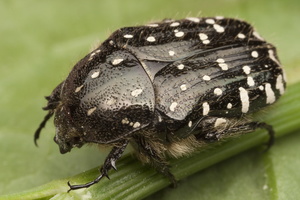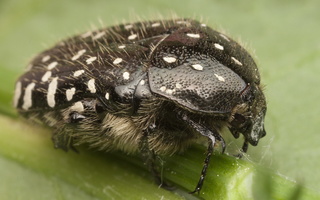 home / Insecta · vabzdžiai / Coleoptera · vabalai / Cetoniidae · auksavabaliai / Oxythyrea funesta · kvapusis auksavabalis
home / Insecta · vabzdžiai / Coleoptera · vabalai / Cetoniidae · auksavabaliai / Oxythyrea funesta · kvapusis auksavabalis
creation date / All / May

- white spotted rose beetle
- Trauer-Rosenkäfer
- pikkukultakuoriainen
- kvapusis auksavabalis
- smirdīgā rožvabole
- Rouwende gouden tor
- łanocha pobrzęcz
- målarguldbagge
- en.wikipedia.org/wiki/Oxythyrea_funesta
- archive.org: ukbeetles.co.uk/oxythyrea-funesta
- gbif.org/species/1077130
This generally thermophilic species is locally common and often abundant throughout southern and central Europe, Mediterranean North Africa, the Middle East and Asia Minor and extends east into Ukraine and Russia, it is present on the Canary Islands and most of the Mediterranean islands and has expanded its range northward over recent decades e.g. in Germany for much of the 20th century it was vary local and scarce in warmer areas of the Upper Rhine and Rhine-Main but over the last 20 years has spread and is now locally common throughout the country, in Belgium it was generally common until the 1950’s when its range contracted and it was known only from areas of calcareous grassland in the south but since 2000 it has spread and is now widespread, and more generally there has been a general shift north, starting from the Czech Republic and including the UK, over the last few decades. In the UK there has been a long and sporadic history of records in England from 1830 but there have been a few scattered 20th century records which have increased greatly in frequency over the last few decades; it is now established in South Hampshire and appears to be expanding its range with recent records from around London, Oxfordshire, Lincolnshire and Devon. The general European expansion is thought to be facilitated by climate change but has very probably been assisted, and definitely so in the case of the UK, by the widespread and rigorous trade in potted trees and shrubs.
Adults are active over a long season, from April until July and in smaller numbers into August or September, they are diurnal and active in bright sun when they fly readily and visit flowers of a range of trees and shrubs as well as herbaceous plants to feed on nectar and pollen, they also consume flower parts and tender foliage which, because they are sometimes very abundant and often the most abundant chafer species in some areas of southern Europe, has sometimes caused them to be classed as a pest species and in some areas traps specifically designed to control them have been used by commercial growers to help protect fruit trees and ornamental shrubs. Reproduction occurs in spring and early summer when mating pairs may be observed on flowers and foliage, females oviposit in the soil where the larvae will develop among roots of herbaceous plants etc, they overwinter in the soil and complete their development during the following spring, they measure about 30mm when fully grown and pupate in a subterranean chamber in early spring, producing adults from April.
7-12 mm, entirely shiny black but often with a faint metallic lustre, with small white dorsal markings to the pronotum, elytra and pygidium. Dorsal surface punctured and finely pubescent throughout, pronotum broadest across the base, with distinct posterior angles and narrowed to a rounded anterior margin, evenly convex but often with shallow depressions around the pale markings. Scutellum triangular, long and sharply acute apically. Elytra slightly depressed inside prominent shoulders, with 3 or 4 variously complete and punctured striae and sometimes shallow longitudinal depressions or weakly convex ridges, lateral margin strongly emarginate in the basal third and continuously rounded apically. Ventral surface black with pale markings along the lateral margins of the abdomen and dense long pale pubescence throughout. Appendages entirely shiny black. Males can be distinguished by a longitudinal row of 4 depressions on the underside of the abdomen.
Kūnas 8 - 12 mm. Juodas arba juodai žalsvas, kartais bronzinio atspalvio. Priešnugarėlė netaisyklingai taškuota, su šešiom baltom dėmelėmis, išsidėsčiusiomis dviem išilginėmis eilėmis. Antsparniai su 5 baltų taškų eilėmis.
Aptinkamas ant įvairių augalų žiedų birželio mėnesį. Lervos vystosi dirvoje, minta augaliniu detritu. Lietuvoje reta rūšis, nors Vilniaus apylinkėse pastaraisiais metais matau dažnai.

